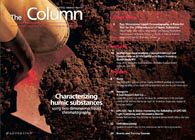NMR/MRI applied to microfluidic chromatography
Researchers with the US Department of Energy (DOE)?s Lawrence Berkeley National Laboratory (Berkeley Lab) have coupled an award-winning remote detection version of NMR/MRI technology with a version of chromatography designed specifically for microfluidic chips giving rise to a portable system for highly sensitive multi-dimensional chemical analysis that could not be achieved with conventional technologies.
Researchers with the US Department of Energy (DOE)’s Lawrence Berkeley National Laboratory (Berkeley Lab) have coupled an award-winning remote detection version of NMR/MRI technology with a version of chromatography designed specifically for microfluidic chips giving rise to a portable system for highly sensitive multi-dimensional chemical analysis that could not be achieved with conventional technologies.
Alexander Pines, a faculty senior scientist in Berkeley Lab’s Materials Sciences Division and the Glenn T. Seaborg Professor of Chemistry at the University of California (UC) Berkeley led a collaboration in which a remote detection NMR/MRI technique that could rapidly identify the chemical constituents of samples in microfluidic “lab-on-a-chip” devices was used to perform analyses in a microscale monolithic chromatograph column. The work was described in a paper titled “Remotely Detected NMR for the Characterization of Flow and Fast Chromatographic Separations Using Organic Polymer Monoliths” in the journal of Analytical Chemistry.
Frantisek Svec, one of the co-authors of the paper and a chemist who directs the Organic and Macromolecular Synthesis facility at Berkeley Lab’s Molecular Foundry, a DOE nanonscience centre, developed the technology for the polymer monolithic column that made the coupling of the two techniques possible. “Polymer monoliths as a separation media can be compared to a single large particle that does not contain inter-particular voids,” says Svec. “As a result, all the mobile phase must pass through the stationary phase as convective flow rather than diffusion during chromatographic processes. This convective flow greatly accelerates the rate of analyte separation.”
Results using the remote NMR/MRI technique with the polymer monoliths showed a much better ability to discriminate between different analytes at the molecular level than comparable analysis using spectrometry based on either mass or optical properties.
For more information, visit www.lbl.govThis story originally appeared in The Column. Click here to view that issue.

Detecting Hyper-Fast Chromatographic Peaks Using Ion Mobility Spectrometry
May 6th 2025Ion mobility spectrometers can detect trace compounds quickly, though they can face various issues with detecting certain peaks. University of Hannover scientists created a new system for resolving hyper-fast gas chromatography (GC) peaks.
University of Oklahoma and UC Davis Researchers Probe Lipidomic Profiles with RP-LC–HRMS/MS
May 6th 2025A joint study between the University of Oklahoma Health Sciences Center (Oklahoma City, Oklahoma) and the UC Davis West Coast Metabolomics Center (Davis, California) identified differentially regulated lipids in type 2 diabetes (T2D) and obesity through the application of reversed-phase liquid chromatography-accurate mass tandem mass spectrometry (RP-LC-accurate MS/MS).
Automated Sample Preparation (ISO 20122) for MOSH/MOAH in Seasoning Oils
May 6th 2025This work presents an Automated Sample Preparation procedure for MOSH/MOAH analysis of Seasoning Oils. We compare results from a manual epoxidation procedure compliant with DIN 16995 with results based on fully automated sample preparation (epoxidation and saponification) compliant with ISO 20122. In both cases, online clean-up via activated aluminum oxide (AlOx) are used to remove interfering n-alkanes from the MOSH fraction during the HPLC run. Automated data evaluation using a dedicated software (GERSTEL ChroMOH) is presented.

.png&w=3840&q=75)

.png&w=3840&q=75)



.png&w=3840&q=75)



.png&w=3840&q=75)









